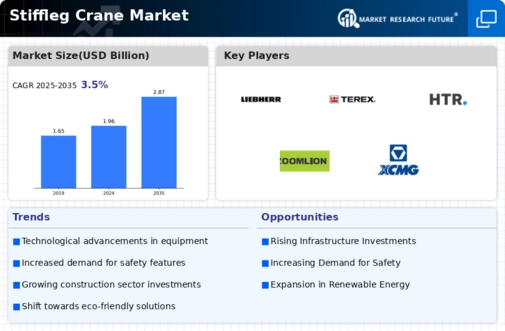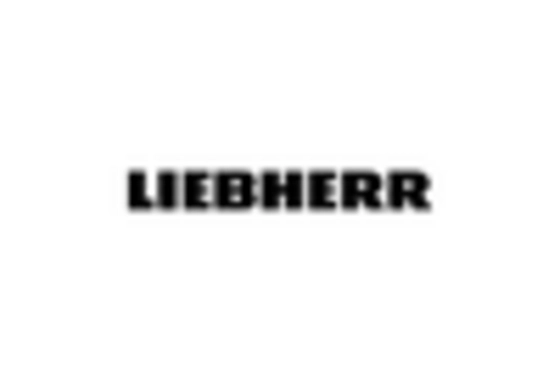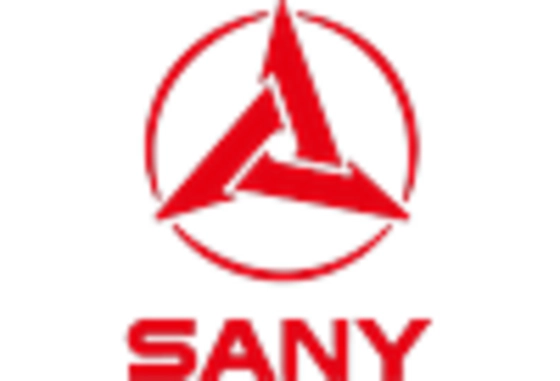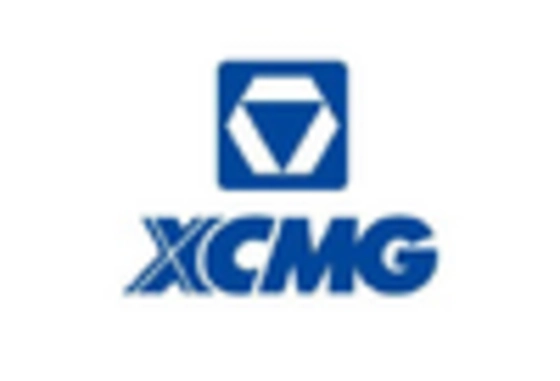Technological Innovations
Technological advancements are playing a crucial role in shaping the Stiffleg Crane Market. Innovations such as improved hydraulic systems and enhanced control mechanisms are making stiffleg cranes more efficient and user-friendly. The integration of smart technologies, including IoT and automation, is expected to revolutionize crane operations, leading to increased productivity and safety. Market data suggests that the adoption of advanced technologies could enhance operational efficiency by up to 30%. As manufacturers continue to invest in research and development, the Stiffleg Crane Market is likely to witness a shift towards more sophisticated models that cater to the evolving needs of the construction industry. This trend not only boosts performance but also aligns with the industry's push for sustainability and reduced operational costs.
Rising Construction Activities
The Stiffleg Crane Market is experiencing a notable surge due to the increasing construction activities across various sectors. Infrastructure development, particularly in urban areas, is driving demand for efficient lifting solutions. As cities expand, the need for cranes that can operate in confined spaces becomes paramount. The construction sector is projected to grow at a compound annual growth rate of approximately 5.5% over the next few years, which directly influences the Stiffleg Crane Market. This growth is further supported by government initiatives aimed at enhancing infrastructure, thereby creating a favorable environment for the adoption of stiffleg cranes. These cranes are particularly valued for their ability to lift heavy loads in challenging environments, making them indispensable in modern construction projects.
Increased Focus on Safety Standards
The Stiffleg Crane Market is significantly influenced by the heightened focus on safety standards within the construction sector. Regulatory bodies are implementing stricter safety regulations to mitigate risks associated with crane operations. This shift is compelling construction companies to invest in high-quality equipment that meets these standards, thereby driving demand for stiffleg cranes. Compliance with safety regulations not only protects workers but also enhances operational efficiency. Market data indicates that companies prioritizing safety can reduce accident-related costs by up to 25%. As a result, the Stiffleg Crane Market is likely to benefit from this trend, as manufacturers develop cranes that incorporate advanced safety features, ensuring compliance and fostering a culture of safety in construction.
Growing Demand in Renewable Energy Sector
The Stiffleg Crane Market is witnessing a growing demand driven by the renewable energy sector. As countries strive to meet their energy needs through sustainable sources, the installation of wind turbines and solar panels has become increasingly prevalent. Stiffleg cranes are particularly suited for these applications due to their ability to handle heavy and awkward loads, which are common in renewable energy projects. Market analysis indicates that the renewable energy sector is expected to grow at a rate of 8% annually, thereby creating substantial opportunities for stiffleg crane manufacturers. This trend not only supports the transition to cleaner energy but also positions the Stiffleg Crane Market as a key player in the evolving energy landscape.
Expansion of Logistics and Transportation Sector
The Stiffleg Crane Market is also being propelled by the expansion of the logistics and transportation sector. As global trade continues to grow, the need for efficient material handling solutions becomes increasingly critical. Stiffleg cranes are essential in loading and unloading heavy cargo, particularly in ports and shipping yards. The logistics sector is projected to grow at a compound annual growth rate of around 6% over the next few years, which directly impacts the demand for stiffleg cranes. This growth is further supported by advancements in supply chain management and the increasing complexity of logistics operations. Consequently, the Stiffleg Crane Market is poised to capitalize on these trends, as companies seek reliable and efficient lifting solutions to enhance their operational capabilities.

















Leave a Comment